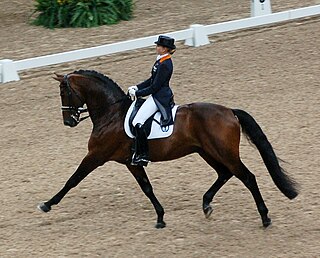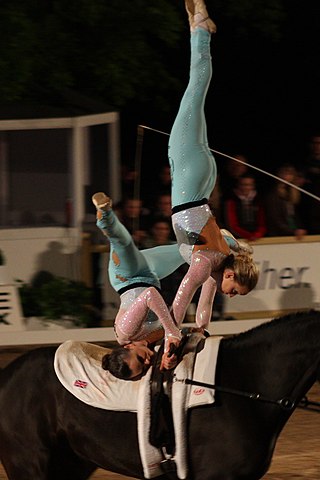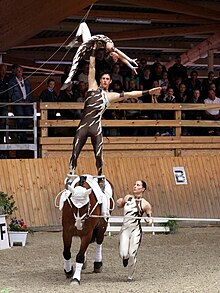
Gymnastics is a type of sport that includes physical exercises requiring balance, strength, flexibility, agility, coordination, artistry and endurance. The movements involved in gymnastics contribute to the development of the arms, legs, shoulders, back, chest, and abdominal muscle groups. Gymnastics evolved from exercises used by the ancient Greeks that included skills for mounting and dismounting a horse, and from circus performance skills.

Dressage is a form of horse riding performed in exhibition and competition, as well as an art sometimes pursued solely for the sake of mastery. As an equestrian sport defined by the International Equestrian Federation, dressage is described as "the highest expression of horse training" where "horse and rider are expected to perform from memory a series of predetermined movements.".

Equestrianism, commonly known as horse riding or horseback riding, includes the disciplines of riding, driving, and vaulting. This broad description includes the use of horses for practical working purposes, transportation, recreational activities, artistic or cultural exercises, and competitive sport.

A horse show is a judged exhibition of horses and ponies. Many different horse breeds and equestrian disciplines hold competitions worldwide, from local to the international levels. Most horse shows run from one to three days, sometimes longer for major, all-breed events or national and international championships in a given discipline or breed. Most shows consist of a series of different performances, called classes, wherein a group of horses with similar training or characteristics compete against one another for awards and, often, prize money.
The International Federation for Equestrian Sports is the international governing body of equestrian sports. The FEI headquarters are in Lausanne, Switzerland.
The FEI World Equestrian Games are the major international championships for equestrianism, and are administered by the Fédération Equestre Internationale (FEI). The games have been held every four years, halfway between sets of consecutive Summer Olympic Games, since 1990. Prior to that year, all ten of the FEI's individual disciplines held separate championships, usually in separate countries. The modern WEG runs over two weeks and, like the Olympics, the location rotates to different parts of the world. Riders and horses competing at WEG go through a rigorous selection process, and each participating country sends teams that have distinguished themselves through competition as the nation's best in each respective discipline. At the 2010 Games, 57 countries were represented by 800 people and their horses.
Freestyle to Music, originated in 1980 by musician Gaynor Colbourn and GB Olympic Rider Jennie Loriston-Clarke MBE, is a form of dressage competition in which movements are performed to matching music resembling ballet or ice dancing. Movements and figures are choreographed to meet the technical requirements of the particular level with carefully chosen music that highlights the horse-rider combination. Musical Freestyle Dressage entertains and appeals not only to devotees of the sport but also to the general public, which has generated a significant increase in global popularity of Dressage. International level competition comprises Prix St. Georges for Young Riders, Intermediate I and Grand Prix through the Fédération Équestre Internationale (FEI).

Malin Birgitta Barijard Johnsson, born 10 April 1975 in Söderköping, Östergötland, Sweden) is a Swedish equestrian, competing in show jumping. Baryard started to ride at the age of six and went on to be a very accomplished show jumper. She won a gold medal in the Swedish Championships at the age of just 14. She married Swedish TV presenter Henrik Johnsson in the summer of 2004, and made her TV-presenting debut in the autumn of 2004 on the SVT show Barbacka.

A pas de deux is an equestrian performance using two horses. The horses perform dressage movements, usually mirroring each other, and almost always accompanied by music. Pas de deux are often performed in exhibitions at special events, and are also used by professional acts, particularly the Spanish Riding School.

Equestrian sports were first included in the Olympic Games in the Summer Olympics of 1900 in Paris. They were again included in 1912, and have been included in every subsequent edition of the Games. The Olympic equestrian disciplines are dressage, eventing, and show-jumping. In each discipline, both individual and team medals are awarded. Women and men compete on equal terms.
Equestrian Canada, formerly known as Equine Canada and commonly known by its acronym, EC, is Canada’s comprehensive national governing body for equestrian sport. It is the executive branch of Canada's Olympic and Paralympic equestrian teams; the national association and registry of Canadian equestrian athletes; the national regulatory body for equestrian coaches, competition organizers, and judges; and the national federation of Canadian horse breeders and Canadian breed registries.

Joanne Idonia Eccles MBE is a British equestrian who competes in the discipline of vaulting. She won the gold medals in the women's individual events at both the 2009 European Championship and the 2010 FEI World Equestrian Games. Her sister Hannah also represents Great Britain in vaulting.

Laura Tomlinson MBE is a German-British dressage rider competing at Olympic level. As of 30 June 2012 the Fédération Équestre Internationale (FEI) ranked her 3rd in the world riding Mistral Højris and 36th on Andretti H. In that year, Tomlinson, riding Mistral Højris under her maiden name of Laura Bechtolsheimer, won two medals in the 2012 Summer Olympics in London; gold for Great Britain in the team dressage with Carl Hester and Charlotte Dujardin, the first ever Olympic team gold in the discipline for her country, and bronze in the individual dressage behind gold medalist and compatriot Dujardin.

Carl Hester is a British dressage rider competing at Olympic level. As of 8 August 2012, the Fédération Équestre Internationale (FEI) rank him 12th in the world riding Uthopia. In 2012, Hester formed part of the Great Britain Dressage team that won gold at the 2012 Summer Olympics.
The 2012 CHIO Aachen was the 2012 edition of the CHIO Aachen, the German official horse show in five horse sport disciplines.
Para-equestrian is an equestrian sport governed by the International Federation for Equestrian Sports (FEI), and includes two competitive events: One is para-equestrian dressage, which is conducted under the same basic rules as conventional dressage, but with riders divided into different competition grades based on their functional abilities. The other is para-equestrian driving, which operates under the same basic rules as combined driving but places competitors in various grades based on their functional abilities.

Equestrian at the 2016 Summer Paralympics consists of 11 dressage events, ten for individual riders across five classes, and a single mixed team, mixed category event. The competitions were held in the Olympic Equestrian Centre in Rio, in September 2016.
The German Equestrian Federation(Deutsche Reiterliche Vereinigung) is an umbrella organization in Germany for equestrian sports and breeding. It is the governing body for the majority of equestrian sports and their organization in Germany, including FEI-recognized disciplines of dressage, eventing, show jumping, vaulting, endurance, reining, para-equestrian, and driving. It also develops and enforces the rules for other events at horse shows. It is colloquially known as FN, short for the international term Fédération Équestre Nationale. The organisation runs the FNverlag, a publishing house for related books and other media
Equestrian competitions at the 2019 Pan American Games in Lima, Peru were held from July 27 to August 10. The venue for the competition is the Equestrian Club Militar La Molina. A total of 150 athletes are scheduled to compete in the three disciplines of dressage, eventing and jumping, each with an individual and team event.
Nathalie Bizet is a French Para-Equestrian Dressage rider. She won a bronze medal.














